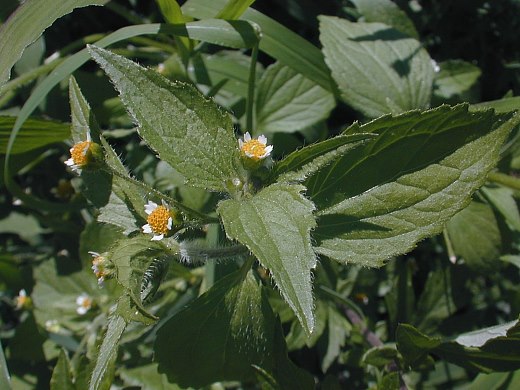Description: This wildflower is a summer annual about ½–2' tall that is sparingly to abundantly branched. The stems have spreading hairs; pairs of opposite leaves occur along these stems. The blades of the leaves are up to 3" long and 2" across; they are medium to dark green, dentate along their margins, and lanceolate to oval-ovate in shape. The upper surfaces of the blades are sparsely to moderately covered with appressed hairs. The slender petioles are up to 1½" long and hairy. Both terminal and axillary cymes of flowerheads are produced from the stems. These small cymes are sparingly branched.

Individual flowerheads
are about ¼" in across; each flowerhead has 4-6 white ray florets along
its margins and numerous yellow disk florets in its center. The ray
florets are very short and 3-toothed at their tips. The base of each
flowerhead is surrounded by scale-like bracts that are green and
oval-ovate in shape; there are approximately 2 outer bracts and several
inner bracts per flowerhead. The blooming
period occurs during the summer and fall and up to 3 generations of
plants can be produced before winter. Both the disk and ray florets are
fertile, producing oblanceoloid achenes. At the apex of each achene
(whether from a disk or ray floret), there is a pappus of several
membranous scales that are usually shorter than the achene. These
scales spread outward as the achenes mature and assist in their
distribution by wind and water. The scales of the ray florets are a
little smaller than those of the disk florets, but nonetheless
well-developed. The root system is very fibrous. Peruvian Daisy spreads
by reseeding itself. It often forms colonies.
Cultivation:
The preference is full or partial sun, moist to mesic conditions, and
fertile soil consisting of loam or clay-loam with high levels of
nitrogen. This weedy wildflower develops very quickly during warm
weather and can reseed itself aggressively.
Range & Habitat:
Peruvian Daisy is occasional to locally common throughout Illinois; it
is especially common in and around cities in the northern two-thirds of
the state. Peruvian Daisy is native to both Central and South America;
it has spread to North America, Eurasia, Africa, and some Pacific
Islands (including Hawaii). Habitats include abandoned fields,
roadsides, gardens, edges of yards, vacant lots, areas along buildings,
and waste areas (especially urban). Disturbed areas that are left
unmowed or are sparingly mowed provide ideal habitat.
Faunal Associations:
Little information is available about floral-faunal relationships. The
florets can be cross-pollinated by insects, otherwise they are
self-fertile.
Photographic Location:
Near a garden at Meadowbrook Park in Urbana, Illinois.
Comments:
This little weed can be identified by the tiny ray florets of the
flowerheads – there are only about 5 of these, far fewer in number than
the tiny disk florets in the center of the flowerhead. Aside from
'Peruvian Daisy,' other common names for this species include 'Shaggy
Soldiers' and 'Common Quickweed,' and Galinsoga ciliata
is a scientific synonym by which this species is occasionally referred.
There is another weedy species in this genus that is less common in
Illinois – this is Galinsoga parviflora (Lesser
Peruvian Daisy), which is also native to Central and South America.
These two species are very similar to each other in appearance and they
prefer similar disturbed habitats. To distinguish them, the achenes of
their ray florets should be examined: For the Peruvian Daisy, the
pappus of such achenes consists of a crown of membranous scales, while
the pappus of such achenes for the Lesser Peruvian Daisy is either
absent or barely visible (a 10x hand lens should be used to make this
distinction). Furthermore, the Peruvian Daisy has spreading hairs along
its stems, while such hairs on the Lesser Peruvian Daisy are more to
likely to be appressed.